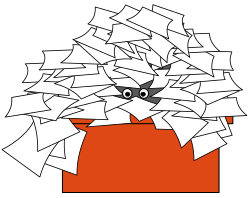Housecleaning/Indoor Litter

When cleaning a house, you can begin by picking up all that litter. Packaging and flyers are mixed in with the important papers scattered about the room from several interrupted and forgotten projects. The litter builds slow enough to be unnoticed until that day of discontent. Perhaps an empty aluminum can is accidentally kicked across the room.
Things needed
- A waste basket
- Patience
- Good judgment
- A dustpan and broom
Notice the litter
[edit | edit source]Imagine what the table or floor would look like if there was nothing on it. Look in a full trash can; then look at the table or floor. Is there a similarity? Now is the time to have patience, because the phone bill might be mixed among the trash on the sofa. It may also be beneficial to have a non-judgemental friend or relative on hand to assist - they will lend a second, more critically-minded pair of eyes to the task of assessing the scene.
Sort the litter
[edit | edit source]
Indoor litter consists of trash plus important papers. Grabbing a messy pile of papers and throwing it away could be a big mistake. You don’t know what’s in that pile of papers. Some of it might be tax documents or the late electric bill The litter needs to be placed into two groups: trash and keep. Judgment is used, and this includes sorting as fast as possible instead of day dreaming.
Trash the trash
[edit | edit source]
Put the pile of trash in the waste basket. Such trash includes old magazines and newspapers, flyers and letters no longer needed. Old opened packages, toothpicks, paper airplanes and paper wads are also trash. After the trash can is full, it is emptied into the garbage can outside.
Put away important papers
[edit | edit source]The important papers discovered in the household litter are put away. Such documents might be owner’s manuals, letters you want to save, or bills you still need to pay. Bills could be put in an in-box on your desk. Owners manuals could be put in a drawer, and so forth. The papers should be neat rather than scattered.
Sweep up the scraps
[edit | edit source]
Little scraps of paper and other debris on the floor then need to be swept into a pile and into the dust pan. Wondering where such scraps come from is sort of a waste of time. Sometime the origin can be guessed at such as in the case of broken potato chips. There is also the possibility of pages being torn from a spiral notebook leaving little scraps of paper. Such speculations are most efficiently done during the sweeping rather than before, and peacefully.
Throw away the scraps
[edit | edit source]After the scraps are on the dustpan they are carried over to the waste basket and dumped into the waste basket. If there is no waste basket in the room, you can carry the dustpan into the kitchen and dump the scraps into the trash can there. Sometimes dust has been swept on to the dustpan also. According to a dictionary, the British call the trash can the dust bin.
Tips and warnings
- Go around the room clockwise.
- In each section, work from ceiling to floor.
- Don’t throw away important papers.
- Don’t blame, just clean. [Bollocks - I blame my cats - Ed]
